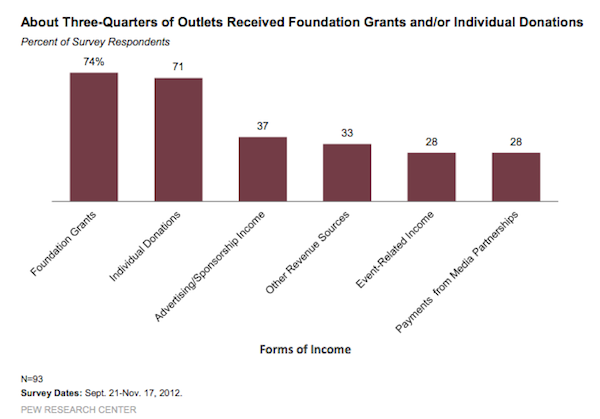
 Even as the number of nonprofit news outlets continues to grow, many organizations are still struggling to find a model for long-term success.
Even as the number of nonprofit news outlets continues to grow, many organizations are still struggling to find a model for long-term success.
A new study from the Pew Research Center found that tending to the business of running a news nonprofit is among the chief concerns from journalists inside those organizations. More than half of the nonprofits surveyed by Pew said business activities like advertising, fundraising, and marketing represented their greatest staffing need.
The report represents one of the more nuanced examinations of the operations of nonprofit news outlets. Finding and generating new dollars is all the more important because the majority of the groups surveyed indicated they raised $500,000 or less in revenue in 2011, the last year with the most complete data. More than half the groups that provided financial data reported having at least three revenue streams. But digging deeper into the finances of those organization, Pew found that half the groups with multiple revenue streams are generating 75 percent of their income from grants — a revenue source whose longevity is still unproven.
Pew surveyed more than 170 online nonprofit news organizations on their business practices, editorial focus, and overall health. The organizations included sites with a national reporting focus and those interested in state and hyperlocal reporting, as well as nonprofits concerned with topic-based reporting like investigative journalism, political reporting, and environmental news.
“At one level we wanted to be able to examine these as a collective unit, as people have begun talking about them as a more longer-term element of the news landscape,” said Amy Mitchell, acting director of the Pew Research Center’s Project for Excellence in Journalism. “The other was to examine very closely their financial structure and the degree to which they seem to be situated for long-term sustainability.”
The financial outlook painted by the report is decidedly mixed. Even as nonprofit news sites flourish, many feel starved of the resources necessary to grow their operation and ensure some kind of financial security. Interestingly, 81 percent of the nonprofits said they believe they’ll be solvent in five years. The reason for that may be that most told Pew they had a steady cash reserve and that they brought in more money than they spent for 2011. “There’s a sense of optimism saying ‘hey, we’re going to get through this to figure it out,'” she said.
That enthusiasm is likely tempered by reality. According to the report, 62 percent of the nonprofits said “finding time for business operations” was a major challenge, with the second largest challenge being the increased competition for grant money.
Unsurprisingly, most of the nonprofits told Pew that producing stories consumed at least half of their staff’s time. None of the organizations reported dedicating more than 49 percent of their time to business, with most saying they spend 10–24 percent of their time on business.
Looking at the budgets of the nonprofit groups explains some of the anxiety around paying more attention to fundraising and business operations. According to the report, 61 percent of the nonprofits said grant dollars made up a third of their initial funding. But at the time of the survey, 28 percent of the nonprofits said those funders agreed to renew those grants. Overall, three-quarters of the organizations said they currently receive funding from foundations.
Outside of foundation dollars, many nonprofits have settled into a combination of donations, advertising (or sponsorships as some like to call it), events, and media partnerships. But those slices of the revenue pie are still slim compared to grant funding.

The growth of nonprofit news organizations has brought increased attention to the IRS process for granting tax-exempt status. But according to the study, only 11 percent of the organizations surveyed by Pew said dealing with IRS tax status issues was a major challenge.
That number is interesting within the context of the report because Pew’s research suggests some groups who have achieved 501(c)(3) status from the IRS are faring better than some of their peers.
Pew found that groups with 501(c)(3) status tended to launch with funding from multiple sources, have larger operating budgets, and overall had larger staffs than those groups dependent on other organizations. These are places like Texas Tribune, the St. Louis Beacon, and the Center for Investigative Reporting, among others. According to Pew, independent groups tended to be more financially stable than news outlets sponsored by another nonprofit organization.
About three-quarters (25 out of 32) reported that they have at least three revenue streams. That compares with less than half (10 out of 23) of those sponsored by non-news organizations and a third (nine out of 27) of those sponsored by universities.

One thing the report makes clear is that building a nonprofit news site is a lean endeavor. According to Pew, the majority of the nonprofits surveyed (78 percent) said they have five or fewer full-time employees.
As Pew found in this survey, many of today’s nonprofit news sites and other organizations were launched during or shortly after the recession. Those economic conditions contributed to a number of local journalists losing their jobs. The report confirms anecdotal proof that many of those reporters launched nonprofit enterprises; more than a third of the nonprofit groups surveyed by Pew said they focus on state news, followed by metro-level news, then national news.
While 26 percent of the outlets covered general interest news, the report found that coverage areas ranged from investigative reporting to health care, environmental news, and government reporting.
As far as the output of most of the sites, Pew says straight news reporting made up the bulk of the content, with stories in the range of 500 words or less. Because of the size of the sites, the report says the number of published pieces falls far short of traditional news organizations. Over a two-week period, almost half of the nonprofits published 10 stories or fewer.
One encouraging sign for the future, the report says that many of the sites continue to see audience growth. Seventy-nine percent of the nonprofit outlets said their traffic has grown in the last year, with a quarter of the sites reporting an increase of more than 75 percent.
Image from 401(K)2012 used under a Creative Commons license.